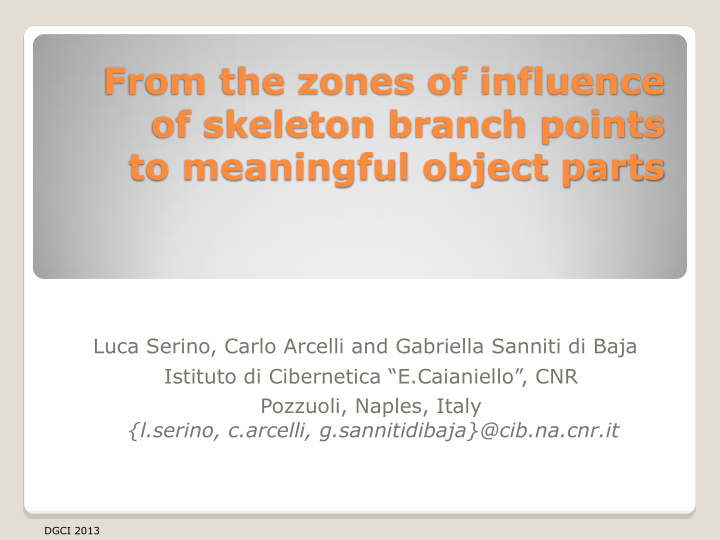



From the zones of influence of skeleton branch points to meaningful object parts Luca Serino, Carlo Arcelli and Gabriella Sanniti di Baja Istituto di Cibernetica “E. Caianiello ”, CNR Pozzuoli, Naples, Italy {l.serino, c.arcelli, g.sannitidibaja}@cib.na.cnr.it DGCI 2013
Outline Why decompose? 3D curve skeleton Object decomposition into disjoint regions via skeleton decomposition Results DGCI 2013
Why decompose? object recognition as a hierarchical process ◦ decompose into parts ◦ analyze the parts ◦ describe the object by a graph nodes: parts edges: adjacency between parts DGCI 2013
Different approaches ◦ pre-defined shape primitives ◦ irregularities in the boundary ◦ object decomposition by means of skeleton decomposition DGCI 2013
2D objects ’ decompostion G. Sanniti di Baja, E. Thiel, "(3,4)-weighted skeleton decomposition for pattern representation and description", Pattern Recognition , 27 , 1039-1049, 1994. DGCI 2013
3D objects ’ decompostion L. Serino, G. Sanniti di Baja, C. Arcelli, Object decomposition via curvilinear skeleton partition, Proc. 20 th ICPR, 2010, pp. 4081 – 4084. L. Serino, G. Sanniti di Baja, C. Arcelli, Using the skeleton for 3D object decomposition, Proc. SCIA 2011, LNCS 6688, Springer, 2011, pp. 447 – 456. DGCI 2013
The 3D curve skeleton C.Arcelli, G.Sanniti di Baja, L.Serino, Distance driven skeletonization in voxel images , IEEE Trans. PAMI, vol. 33, no. 4, pp. 709-720, 2011. DGCI 2013
The method Skeleton decomposition Identification of all skeleton branches Detection of the significant branches by means of the zones of influence of the branch points Object decomposition Detection of the overlapping regions via the reverse distance transformation of the zones of influence Detection of the object’s parts via the subtraction of the overlapping regions from the input object Assignment of the overlapping regions to the adjacent object’s parts DGCI 2013
Running example DGCI 2013
Skeleton decomposition DGCI 2013
From skeleton to object decomposition DGCI 2013
Overlapping regions detection
Object ’ s parts via overlapping regions subtraction DGCI 2013
Assignment of the overlapping regions R 1 = A P1 /A OR1 R 2 = A P2 /A OR1 R 3 = A P3 /A OR1 R 4 = A P4 /A OR1 P 1 OR 1 P 4 P 2 P 3 DGCI 2013
Some results DGCI 2013
Results for 3D objects in different poses/sizes DGCI 2013
Stability DGCI 2013
Extending the image domain DGCI 2013
Questions? Thank you! DGCI 2013
Recommend
More recommend